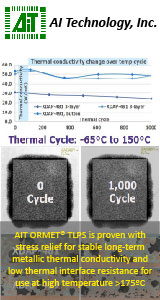|

|
|
| Ask the Experts | |||||||
|
|||||||
|
February 8, 2019 - Updated July 5, 2007 - Originally Posted Problems with defect BGA connections on large BGA's and on ENIG plated boardsWe are an EMS. Lately we are facing a new challenge. Our customers send us RMA's with defect BGA connections but only on large BGA's and on ENIG plated boards from the same board manufacturer. We experienced these defects with at least two different customers. The defect is always at the same large BGA's and in the same area prone to mechanical stresses after component assembly. The assemblies are mechanically mounted at the customer's facilities. Our printed circuit supplier does not accept our complaint that the finish is not suitable. Our customers don't want to try another finish like immersion silver, and also sustain that their design is good. We are in the middle of all this, and really upset. Our profile is checked for these large BGA's and is according to the component manufacturer's requirements. In our facility we do not exercise any mechanical stresses in the vicinity of the failed area. What to do? G.B. |
|||||||
| Expert Panel Responses | |||||||
|
In my opinion....40% of the task is materials/solderability....20% is mechanics (alignment/placement/pcb+component handling)....40% is thermal profile. I would look at making sure your chemistry is correct....and also your thermal profiling. Are you warping the pcbs during reflow? If so, a lot of stress will be induced in your assembly...which will lead to subsequent failures. You may need to slow the preheating rate down, allowing heat to evenly perculate through the whole structure, to reduce the warping. Also the reflow temperature + soak times need to be sufficient to allow the bonding to occur...your solder manufacturer will have guidelines to follow. Only my thoughts...
Managing Director PDR Twenty years ago Mr. Gibbs, Managing Director of PDR, produced the first rework system based on Focused Infra-Red light energy. PDR now has a 3,500-strong global installation list with top OEMs and EMS providers.
You may want to try a step up stencil in the BGA area; step up to 8 mil thick. This may help with large BGA's
Vice President Technology Photo Stencil For over 18 years, Dr. Coleman has been the vice president of technology for Photo Stencil, working closely with customers to understand their printing requirements. His efforts have resulted in several new stencil products.
The industry is starting to recognize this as a systematic problem. For reasons currently unknown, BGAs assembled to ENIG-plated boards that are exposed to a second reflow operation periodically experience a severe weakness in the solder joint or, in more extreme cases, dewetting. If you could send me some images of this defect, I can give you some feedback if this is indeed your affliction.
CEO & Managing Partner DfR Solutions Dr. Hillman's specialties include best practices in Design for Reliability, strategies for transitioning to Pb-free, supplier qualification, passive component technology and printed board failure mechanisms.
I have seen this type of problem before. Although you may or may not be mechanically stressing it, it is likely it is being stressed during handling, packaging, shipping or when your customer is handling it. Unless it is a backplane and extremely rigid this would likely be the culprit. The solution is handling and storing the boards on a flat surface. ESD safe plastic trays are the best way, as the board is fully supported on a flat surface. The operators are handling the tray, not the board, the board will never see stress. You and your customer need to use the same method for handling. The prior industry method before trays and tray carts was carts or racks with slotted side panels and the boards would hang from two edges and sag in the middle and frequently fracture solder joints on BGA's and or circuits. These older rack methods are still around, but the industry is changing. You can get trays and tray carts from a variety of companies, including mine. I hope this solves the problem for you.
President & CEO - Retired Bliss Industries, Inc. Retired - Mr. Bliss has 20+ years experience creating process methods that improve profitability by maximizing hidden unused capacity and throughput. Ken has expertise in all areas of manufacturing specializing in electronics assembly.
Reader Comment
I also have experienced the same problem earlier. ENIG is more reliable finish for larger BGA's and fine pitch components. You may have to see the possibility of component or PCB warpage in the process.
Consider preheating the components or PCBs before assembly, if your component manufacturer has recommended. The solder paste manufacturer has more guidelines which can help you in establishing a high reliable Reflow profile. Consider the stencil aperture design recommended by IPC7525 which will solve majority of your problem.
Subburaj, Amphenol, India
|
|||||||
| Submit A Comment | |||||||
|
Comments are reviewed prior to posting. You must include your full name to have your comments posted. We will not post your email address. |
|
Free Newsletter Subscription
Circuitnet is built for professionals who bear the responsibility of looking ahead, imagining the future, and preparing for it. Insert Your Email Address |
|

|






